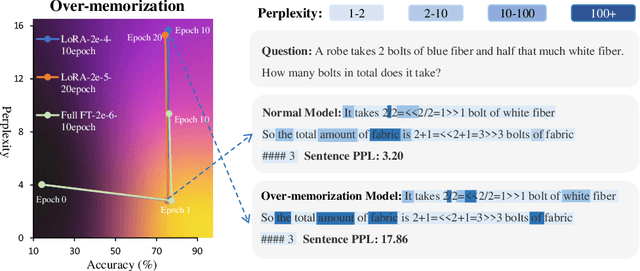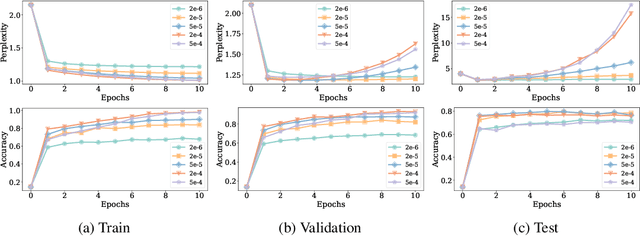Guanhua Chen
MoMA: A Mixture-of-Multimodal-Agents Architecture for Enhancing Clinical Prediction Modelling
Aug 07, 2025Abstract:Multimodal electronic health record (EHR) data provide richer, complementary insights into patient health compared to single-modality data. However, effectively integrating diverse data modalities for clinical prediction modeling remains challenging due to the substantial data requirements. We introduce a novel architecture, Mixture-of-Multimodal-Agents (MoMA), designed to leverage multiple large language model (LLM) agents for clinical prediction tasks using multimodal EHR data. MoMA employs specialized LLM agents ("specialist agents") to convert non-textual modalities, such as medical images and laboratory results, into structured textual summaries. These summaries, together with clinical notes, are combined by another LLM ("aggregator agent") to generate a unified multimodal summary, which is then used by a third LLM ("predictor agent") to produce clinical predictions. Evaluating MoMA on three prediction tasks using real-world datasets with different modality combinations and prediction settings, MoMA outperforms current state-of-the-art methods, highlighting its enhanced accuracy and flexibility across various tasks.
Unveiling Over-Memorization in Finetuning LLMs for Reasoning Tasks
Aug 06, 2025



Abstract:The pretrained large language models (LLMs) are finetuned with labeled data for better instruction following ability and alignment with human values. In this paper, we study the learning dynamics of LLM finetuning on reasoning tasks and reveal the uncovered over-memorization phenomenon during a specific stage of LLM finetuning. At this stage, the LLMs have excessively memorized training data and exhibit high test perplexity while maintaining good test accuracy. We investigate the conditions that lead to LLM over-memorization and find that training epochs and large learning rates contribute to this issue. Although models with over-memorization demonstrate comparable test accuracy to normal models, they suffer from reduced robustness, poor out-of-distribution generalization, and decreased generation diversity. Our experiments unveil the over-memorization to be broadly applicable across different tasks, models, and finetuning methods. Our research highlights that overparameterized, extensively finetuned LLMs exhibit unique learning dynamics distinct from traditional machine learning models. Based on our observations of over-memorization, we provide recommendations on checkpoint and learning rate selection during finetuning.
An Information-Theoretic Perspective on Multi-LLM Uncertainty Estimation
Jul 09, 2025Abstract:Large language models (LLMs) often behave inconsistently across inputs, indicating uncertainty and motivating the need for its quantification in high-stakes settings. Prior work on calibration and uncertainty quantification often focuses on individual models, overlooking the potential of model diversity. We hypothesize that LLMs make complementary predictions due to differences in training and the Zipfian nature of language, and that aggregating their outputs leads to more reliable uncertainty estimates. To leverage this, we propose MUSE (Multi-LLM Uncertainty via Subset Ensembles), a simple information-theoretic method that uses Jensen-Shannon Divergence to identify and aggregate well-calibrated subsets of LLMs. Experiments on binary prediction tasks demonstrate improved calibration and predictive performance compared to single-model and naive ensemble baselines.
Towards Bridging the Reward-Generation Gap in Direct Alignment Algorithms
Jun 11, 2025Abstract:Direct Alignment Algorithms (DAAs), such as Direct Preference Optimization (DPO) and Simple Preference Optimization (SimPO), have emerged as efficient alternatives to Reinforcement Learning from Human Feedback (RLHF) algorithms for aligning large language models (LLMs) with human preferences. However, DAAs suffer from a fundamental limitation we identify as the "reward-generation gap" -- a misalignment between optimization objectives during training and actual generation performance during inference. In this paper, we find a contributor to the reward-generation gap is the mismatch between the inherent importance of prefix tokens during the LLM generation process and how this importance is reflected in the implicit reward functions of DAAs. To bridge the gap, we introduce a simple yet effective approach called Prefix-Oriented Equal-length Training (POET), which truncates both preferred and dispreferred responses to match the shorter one's length. Training with POET, where both responses in each sample are truncated to equal length, resulting in diverse truncated lengths across samples, the optimization of DAAs objective is implicitly constrained to converge across all positions, thus paying more attention to prefix tokens than the standard DAAs. We conduct experiments with DPO and SimPO, two representative DAAs, demonstrating that POET improves over their standard implementations, achieving up to 15.6 points in AlpacaEval 2 and overall improvements across downstream tasks. Our results highlight the importance of addressing the misalignment between reward optimization and generation performance in DAAs.
Automatic Robustness Stress Testing of LLMs as Mathematical Problem Solvers
Jun 05, 2025Abstract:Large language models (LLMs) have achieved distinguished performance on various reasoning-intensive tasks. However, LLMs might still face the challenges of robustness issues and fail unexpectedly in some simple reasoning tasks. Previous works evaluate the LLM robustness with hand-crafted templates or a limited set of perturbation rules, indicating potential data contamination in pre-training or fine-tuning datasets. In this work, inspired by stress testing in software engineering, we propose a novel framework, Automatic Robustness Checker (AR-Checker), to generate mathematical problem variants that maintain the semantic meanings of the original one but might fail the LLMs. The AR-Checker framework generates mathematical problem variants through multi-round parallel streams of LLM-based rewriting and verification. Our framework can generate benchmark variants dynamically for each LLM, thus minimizing the risk of data contamination. Experiments on GSM8K and MATH-500 demonstrate the strong performance of AR-Checker on mathematical tasks. We also evaluate AR-Checker on benchmarks beyond mathematics, including MMLU, MMLU-Pro, and CommonsenseQA, where it also achieves strong performance, further proving the effectiveness of AR-Checker.
TAG-INSTRUCT: Controlled Instruction Complexity Enhancement through Structure-based Augmentation
May 24, 2025Abstract:High-quality instruction data is crucial for developing large language models (LLMs), yet existing approaches struggle to effectively control instruction complexity. We present TAG-INSTRUCT, a novel framework that enhances instruction complexity through structured semantic compression and controlled difficulty augmentation. Unlike previous prompt-based methods operating on raw text, TAG-INSTRUCT compresses instructions into a compact tag space and systematically enhances complexity through RL-guided tag expansion. Through extensive experiments, we show that TAG-INSTRUCT outperforms existing instruction complexity augmentation approaches. Our analysis reveals that operating in tag space provides superior controllability and stability across different instruction synthesis frameworks.
PlanGPT-VL: Enhancing Urban Planning with Domain-Specific Vision-Language Models
May 21, 2025Abstract:In the field of urban planning, existing Vision-Language Models (VLMs) frequently fail to effectively analyze and evaluate planning maps, despite the critical importance of these visual elements for urban planners and related educational contexts. Planning maps, which visualize land use, infrastructure layouts, and functional zoning, require specialized understanding of spatial configurations, regulatory requirements, and multi-scale analysis. To address this challenge, we introduce PlanGPT-VL, the first domain-specific Vision-Language Model tailored specifically for urban planning maps. PlanGPT-VL employs three innovative approaches: (1) PlanAnno-V framework for high-quality VQA data synthesis, (2) Critical Point Thinking to reduce hallucinations through structured verification, and (3) comprehensive training methodology combining Supervised Fine-Tuning with frozen vision encoder parameters. Through systematic evaluation on our proposed PlanBench-V benchmark, we demonstrate that PlanGPT-VL significantly outperforms general-purpose state-of-the-art VLMs in specialized planning map interpretation tasks, offering urban planning professionals a reliable tool for map analysis, assessment, and educational applications while maintaining high factual accuracy. Our lightweight 7B parameter model achieves comparable performance to models exceeding 72B parameters, demonstrating efficient domain specialization without sacrificing performance.
Code2Logic: Game-Code-Driven Data Synthesis for Enhancing VLMs General Reasoning
May 20, 2025Abstract:Visual-language Chain-of-Thought (CoT) data resources are relatively scarce compared to text-only counterparts, limiting the improvement of reasoning capabilities in Vision Language Models (VLMs). However, high-quality vision-language reasoning data is expensive and labor-intensive to annotate. To address this issue, we leverage a promising resource: game code, which naturally contains logical structures and state transition processes. Therefore, we propose Code2Logic, a novel game-code-driven approach for multimodal reasoning data synthesis. Our approach leverages Large Language Models (LLMs) to adapt game code, enabling automatic acquisition of reasoning processes and results through code execution. Using the Code2Logic approach, we developed the GameQA dataset to train and evaluate VLMs. GameQA is cost-effective and scalable to produce, challenging for state-of-the-art models, and diverse with 30 games and 158 tasks. Surprisingly, despite training solely on game data, VLMs demonstrated out of domain generalization, specifically Qwen2.5-VL-7B improving performance by 2.33\% across 7 diverse vision-language benchmarks. Our code and dataset are available at https://github.com/tongjingqi/Code2Logic.
ImPart: Importance-Aware Delta-Sparsification for Improved Model Compression and Merging in LLMs
Apr 17, 2025Abstract:With the proliferation of task-specific large language models, delta compression has emerged as a method to mitigate the resource challenges of deploying numerous such models by effectively compressing the delta model parameters. Previous delta-sparsification methods either remove parameters randomly or truncate singular vectors directly after singular value decomposition (SVD). However, these methods either disregard parameter importance entirely or evaluate it with too coarse a granularity. In this work, we introduce ImPart, a novel importance-aware delta sparsification approach. Leveraging SVD, it dynamically adjusts sparsity ratios of different singular vectors based on their importance, effectively retaining crucial task-specific knowledge even at high sparsity ratios. Experiments show that ImPart achieves state-of-the-art delta sparsification performance, demonstrating $2\times$ higher compression ratio than baselines at the same performance level. When integrated with existing methods, ImPart sets a new state-of-the-art on delta quantization and model merging.
Not All LoRA Parameters Are Essential: Insights on Inference Necessity
Mar 30, 2025Abstract:Current research on LoRA primarily focuses on minimizing the number of fine-tuned parameters or optimizing its architecture. However, the necessity of all fine-tuned LoRA layers during inference remains underexplored. In this paper, we investigate the contribution of each LoRA layer to the model's ability to predict the ground truth and hypothesize that lower-layer LoRA modules play a more critical role in model reasoning and understanding. To address this, we propose a simple yet effective method to enhance the performance of large language models (LLMs) fine-tuned with LoRA. Specifically, we identify a ``boundary layer'' that distinguishes essential LoRA layers by analyzing a small set of validation samples. During inference, we drop all LoRA layers beyond this boundary. We evaluate our approach on three strong baselines across four widely-used text generation datasets. Our results demonstrate consistent and significant improvements, underscoring the effectiveness of selectively retaining critical LoRA layers during inference.
 Add to Chrome
Add to Chrome Add to Firefox
Add to Firefox Add to Edge
Add to Edge